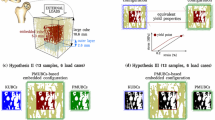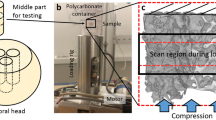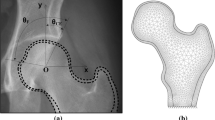Abstract
The mechanical properties of the pelvic trabecular bone have been studied at the continuum level. However, nothing is known about the tissue-level damage in the trabecular bone of the healthy human acetabulum at apparent small strains characteristic of habitual. By a DAWING 4000 A supercomputer, nonlinear micro-finite element (μFE) analysis was performed to quantify tissue-level damage accumulation in trabecular bone at small strains. The data indicate that damage in trabecular bone commence at 0.2% apparent strain. The findings imply that tissue yielding can initiate at very low strains in the trabecular bone of the healthy acetabulum and that this local failure has negative consequences on the apparent mechanical properties of trabecular bone.
Similar content being viewed by others
References
Muir P, Johnson K A, Ruaux-Mason C P. In vivo matrix microdamage in a naturally occurring canine fatigue fracture [J]. Bone, 1999, 25(5): 571–576.
Mashiba T, Turner C H, Hirano T, et al. Effects of suppressed bone turnover by bisphosphonates on microdamage accumulation and biomechanical properties in clinically relevant skeletal sites in beagles [J]. Bone, 2001, 28(5): 524–531.
Arthur Moore T L, Gibson L J. Microdamage accumulation in bovine trabecular bone in uniaxial compression [J]. J Biomech Eng, 2002, 124(1):63–71.
Martin R B. Is all cortical bone remodeling initiated by microdamage? [J]. Bone, 2002, 30(1): 8–13.
Li J, Mashiba T, Burr D B. Bisphosphonate treatment suppresses not only stochastic remodeling but also the targeted repair of microdamage [J]. Calcif Tissue Int, 2001, 69(5): 281–286.
Cooper C. The epidemiology of fragility fractures: is there a role for bone quality? [J]. Calcif Tissue Int, 1993, 53(S1): 23–26.
Burr D B, Milgrom C, Fyhrie D, et al. In vivo measurement of human tibial strains during vigorous activity [J]. Bone, 1996, 18(5): 405–410.
Van Rietbergen B, Huiskes R, Eckstein F, et al. Trabecular bone tissue strains in the healthy and osteoporotic human femur [J]. J Bone Miner Res, 2003, 18(10): 1781–1788.
Pedersen D R, Crowninshield R D, Brand R A, et al. An axisymmetric model of acetabular components in total hip arthroplasty [J]. J Biomech, 1982, 15(4): 305–315.
Dalstra M, Huiskes R, Odgaard A, et al. Mechanical and textural properties of pelvic trabecular bone [J]. J Biomech, 1993, 26(4–5): 523–535.
Keaveny T M, Wachtel E F, Kopperdahl D L. Mechanical behavior of human trabecular bone after overloading [J]. J Orthop Res, 1999, 17(3): 346–353.
Keaveny T M, Pinilla T P, Crawford R P, et al. Systematic and random errors in compression testing of trabecular bone [J]. J Orthop Res, 1997, 15(1): 101–110.
Bayraktar H H, Morgan E F, Niebur G L, et al. Comparison of the elastic and yield properties of human femoral trabecular and cortical bone tissue [J]. J Biomech, 2004, 37(1): 27–35.
Morgan E F, Yeh O C, Keaveny T M. Damage in trabecular bone at small strains [J]. Eur J Morphol, 2005, 42(1–2): 13–21.
Keaveny T M, Wachtel E F, Guo X E, et al. Mechanical behavior of damaged trabecular bone [J]. J Biomech, 1994, 27(11): 1309–1318.
Niebur G L, Feldstein M J, Yuen J C, et al. High-resolution finite element models with tissue strength asymmetry accurately predict failure of trabecular bone [J]. J Biomech, 2000, 33(12): 1575–1583.
Wang X, Masse D B, Leng H, et al. Detection of trabecular bone microdamage by micro-computed tomography [J]. J Biomech, 2007, 40(15): 3397–3403.
Kim D G, Christopherson G T, Dong X N, et al. The effect of microcomputed tomography scanning and reconstruction voxel size on the accuracy of stereological measurements in human cancellous bone [J]. Bone, 2004, 35(6): 1375–1382.
Yeni Y N, Christopherson G T, Dong X N, et al. Effect of microcomputed tomography voxel size on the finite element model accuracy for human cancellous bone [J]. J Biomech Eng, 2005, 127(1): 1–8.
Muller R, Gerber S C, Hayes WC. Micro-compression: A novel technique for the nondestructive assessment of local bone failure [J]. Technol Health Care, 1998, 6(5–6): 433–444.
Wachtel E F, Keaveny T M. Dependence of trabecular damage on mechanical strain [J]. J Orthop Res, 1997, 15(5): 781–787.
Yeh O C, Keaveny T M. Relative roles of microdamage and microfracture in the mechanical behavior of trabecular bone [J]. J Orthop Res, 2001, 19(6): 1001–1007.
Morgan E F, Yeh O C, Chang W C, et al. Nonlinear behavior of trabecular bone at small strains [J]. J Biomech Eng, 2001, 123(1): 1–9.
Wenzel T E, Schaffler M B, Fyhrie D P. In vivo trabecular microcracks in human vertebral bone [J]. Bone, 1996, 19(2): 89–95.
Nagaraja S, Lin A S, Guldberg R E. Age-related changes in trabecular bone microdamage initiation [J]. Bone, 2007, 40(4): 973–980.
Morgan E F, Keaveny T M. Dependence of yield strain of human trabecular bone on anatomic site [J]. J Biomech, 2001, 34(5): 569–577.
Kopperdahl D L, Keaveny T M. Yield strain behavior of trabecular bone [J]. J Biomech, 1998, 31(7): 601–608.
Burr D B. Remodeling and the repair of fatigue damage [J]. Calcif Tissue Int, 1993, 53(S1): 75–80.
Heaney R P. Is there a role for bone quality in fragility fractures? [J]. Calcif Tissue Int, 1993, 53(S1): 3–5.
Tami A E, Nasser P, Schaffler M B, et al. Noninvasive fatigue fracture model of the rat ulna [J]. J Orthop Res, 2003, 21(6): 1018–1024.
Burr D B, Milgrom C, Boyd R D, et al. Experimental stress fractures of the tibia. Biological and mechanical aetiology in rabbits [J]. J Bone Joint Surg Br, 1990, 72(3): 370–375.
Turner C H, Rho J, Takano Y, et al. The elastic properties of trabecular and cortical bone tissues are similar: results from two microscopic measurement techniques [J]. J Biomech, 1999, 32(4): 437–441.
Rho J Y, Ashman R B, Turner C H. Young’s modulus of trabecular and cortical bone material: Ultrasonic and microtensile measurements [J]. J Biomech, 1993, 26(2): 111–119.
Author information
Authors and Affiliations
Corresponding author
Additional information
Foundation item: the National High Technology Research and Development Program (863) of China (No. 2006AA02A137; the Postgraduate Creativity Foundation of Shanghai Jiaotong University (No. BXJ 0730)
Rights and permissions
About this article
Cite this article
Ding, H., Zhu, Za., Dai, Kr. et al. Research on damage in trabecular bone of the healthy human acetabulum at small strains using nonlinear micro-finite element analysis. J. Shanghai Jiaotong Univ. (Sci.) 13, 623–628 (2008). https://doi.org/10.1007/s12204-008-0623-5
Received:
Published:
Issue Date:
DOI: https://doi.org/10.1007/s12204-008-0623-5
Key words
- mechanical property
- trabecular bone
- microcomputed tomography (μCT)
- nonlinear micro-finite element (μFE) analysis
- acetabulum




